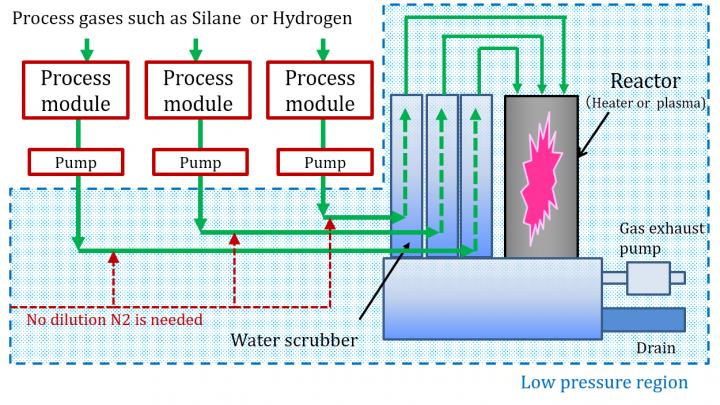Development of a low-energy, high-efficiency exhaust gas abatement system

Credit: Kanken Techno Co.,Ltd
Manufacturing process for industries of electronics, such as semiconductors, flat panel displays, and solar batteries uses dangerous toxic and flammable gases, such as silane gas and hydrogen gas. Currently, to detoxify these dangerous gases, a thermal oxidation reaction, in which they are heated to 1000? or more and decomposed is mainly used. For example, as silane gas, which is often used in the chemical vapor disposition (CVD) (1) process for semiconductors, causes an explosive reaction when it comes into contact with the air, after diluting the concentration with large amounts of nitrogen gas so that the concentration is below the lower explosion limit (2), it can be heat-treated and detoxified. Previously, the development of reacting furnace structures was limited to improving the efficiency of heating means and reducing wasted energy, such as heat dissipation, so the development of a drastic technology that can realize energy savings has become an important issue.
In the JST Adaptable and Seamless Technology Transfer Program through Target-driven R&D (A-STEP), corporate development for detoxifying dangerous gases with high efficiency and low energy has been entrusted to Kanken Techno Co. Ltd, based on the results of the research by Professor Takanori Ichiki of the Graduate School of Engineering, the University of Tokyo.
The development team has focused on the fact that the lower explosion limit depends on pressure of flammable gases and examined the pressure conditions at which the amount of dilution gases can be reduced. Reducing the pressure within the pipe from the pump outlet of the device manufacturing equipment to the exhaust gas abatement device, they created an environment in which the lower explosion limit was increased and no chemical reaction was caused. Additionally, as the heat source for breaking down exhaust gases, they discovered the optimal conditions for stably generating arc plasma(3), which is normally generated in atmospheric pressure, in a reduced pressure state of approximately 0.1 to 10 kPa. In this way, they made it possible to perform detoxification processing by thermally reacting the dangerous gas with oxygen, using the arc plasma heat source, within an exhaust gas abatement device in a reduced pressure state. Since dilution with large quantities of nitrogen gas is unnecessary with the CVD process, the amount of energy required for exhaust gas processing has been successfully reduced by up to 75% when processing silane gas.
The developed abatement system can be simply applied to exhaust gases containing flammable gases requiring nitrogen gas dilution other than silane gas by optimizing the processing conditions, without changing the device structure. This promises to find applications in manufacturing devices using hydrogen gases, such as the hydrogen processing of silicon wafers, epitaxial growth(4), and ashing of organic films(5).
A-STEP is a technology transfer support program whose aim is to put the research results by public research institutes into practical applications as important technology in the national economy, and thus to give something back to society.
###
For detailed information, see https:/
(1) Chemical Vapor Deposition (CVD)
This is a synthetic method of producing thin film materials, and is a method of depositing thin film on a substrate, by supplying source gas containing thin film structural elements into a reactor vessel, and decomposing and causing a chemical reaction in the source gas on a substrate wafer.
(2) Lower Explosion Limit (LEL)
When flammable gases or flammable liquids are mixed with air or oxygen, and there is an ignition source within a specific gas concentration range, this causes an explosion. This concentration range is referred to as the explosion range, the lower concentration is the lower explosion limit, and the higher side limit is the upper explosion limit.
(3) Arc plasma
This is the plasma generated in the situation in which, when energy is discharged between two electrodes, the electrical current increases and the voltage between electrodes decreases. The temperature of the electrons, ions, and neutral gas atoms/molecules becomes virtually the same. Arc plasma is characterized by the fact that voltage is low voltage (10 to several dozen volts), and the current is a large current value (100 to 1000 amperes).
(4) Epitaxial growth
This is a thin film crystal growth technology, and its form is created when crystal growth is performed on a substrate crystal and when it grows in a way that it is arranged in line with the base substrate crystal surface. This is a technology used when creating the surface of high-quality semiconductor wafers etc.
(5) Ashing
This is a process in which radicals and ions etc. are irradiated onto a resin surface, such as a photoresist, thus vaporizing and decomposing the resin. Plasma, such as oxygen gas or hydrogen gas, is used. It is also referred to as ash processing or stripping.
Media Contact
Michihiko Yanagisawa
[email protected]
Original Source
https:/




